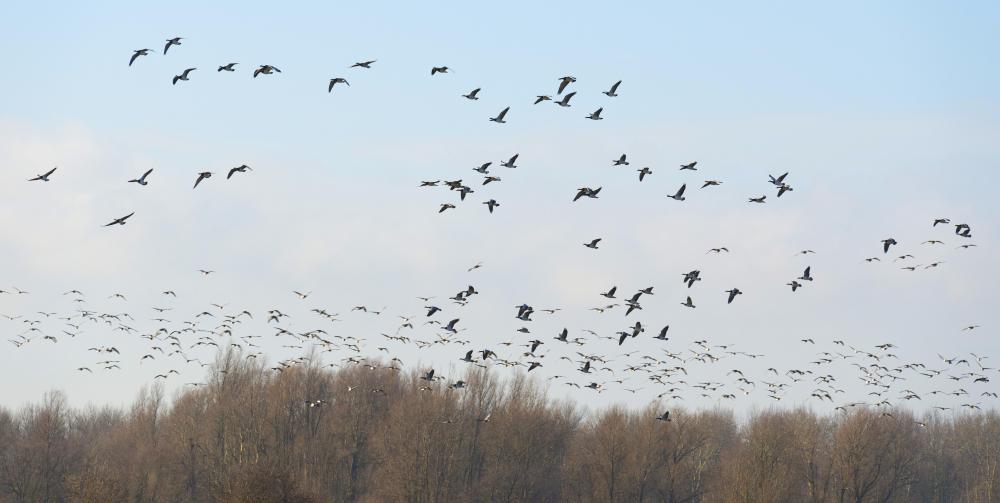At AllThingsNature, we're committed to delivering accurate, trustworthy information. Our expert-authored content is rigorously fact-checked and sourced from credible authorities. Discover how we uphold the highest standards in providing you with reliable knowledge.
What is a Redhead Duck?
The redhead duck, or Aythya americana, is a diving duck found throughout North America and parts of Europe, Asia, and the South Pacific. It lives in ponds, bays, lakes, marshes, and other watery habitats. The species gets its name from the distinctive brick-red-colored head of the male redhead duck.
Ducks are part of the Anatidae family, along with geese, swans, and other water fowl. These birds tend to congregate in very large flocks on water bodies. They also often fly in small groups in v-shaped formations.
The redhead duck is a medium-sized duck with a stout, squat body. The top of its head is very round as well. An adult weighs just over 2 pounds (about 1 kg) and measures about 19 inches (48.3 cm) long when fully grown.

Male and female redhead ducks differ in appearance. For example, the male’s head is much redder than the female’s head. The male also has a grayish midsection and a gray-black or black chest and rump. He has bright yellow-orange eyes and a light blue bill with a black tip. The female is dully colored in brown and gray, with brown eyes and a dark grayish-blue bill tipped with black.
Redhead ducks mostly eat aquatic plants. They also eat insects and tiny mollusks and fish. They can dive underwater in search of food, but they also dabble, which means they snatch up food while they are floating atop the water surface.
The northwest United States and southwest Canada are common breeding areas for North American redhead ducks. They typically breed in the summer and migrate to the south and east for the winter. Winter flocks can contain tens of thousands of the birds.
The redhead duck prefers to nest in marshy areas containing shallow water, and it builds nests using dead vegetation and down. Many duck species practice parasitic nesting behavior. This means the females lay at least some eggs in the nests of other ducks. Female redhead ducks are well-known for doing this. They may also “dump” eggs by laying them in untended nests. These eggs are essentially abandoned.
Male redhead ducks do not help their mates tend to the eggs or raise the young. The males leave the nesting area soon after the eggs are laid. Male and female juveniles are dully colored, much like the female adults. The mothers stay with the young until the juveniles can fly, approximately two to three months after hatching.
Most types of ducks undergo at least one complete molt annually, in which they shed and regrow all their feathers. The molting process can take several weeks. During this time, the ducks are unable to fly due to the temporary loss of their wing feathers.
Male redhead ducks undergo a complete molt soon after mating and after migrating to their winter territories. They lose their brightly colored feathers and take on the duller appearance of the females; they remain flightless for about two to four weeks. As breeding season approaches, they undergo a partial molt, in which they shed their dull body feathers and regrow brightly colored feathers.
Female redhead ducks undergo a complete molt soon before nesting, becoming even duller in color. This helps them blend in with vegetation and avoid predators during nesting. The females are flightless for several weeks while they tend to their eggs and newly hatched young. Then, they undergo a partial molt and regain their usual coloring.
Frequently Asked Questions
What is a Redhead Duck?
A Redhead Duck is a medium-sized diving duck with a rounded head and a broad, blue bill. The male is known for its striking chestnut-red head and bright yellow eyes, while the female has a brownish head and body. They breed in marshes and prairie potholes of North America and migrate to the southern United States and Mexico for winter.
What does the Redhead Duck eat?
Redhead Ducks are omnivorous and have a varied diet that changes with the seasons. They primarily feed on aquatic plants, seeds, and tubers, but also consume mollusks, insects, and small fish. During breeding season, they may eat more protein-rich foods to help with egg production, according to the Cornell Lab of Ornithology.
How do Redhead Ducks reproduce?
Redhead Ducks are known for their unique breeding behavior, often laying eggs in the nests of other ducks, especially Canvasbacks and other pochards. This behavior, known as brood parasitism, allows them to increase their reproductive output. They also make their own nests in dense marsh vegetation, where they lay an average of 7-10 eggs.
Are Redhead Ducks endangered?
Redhead Ducks are not currently considered endangered. They are listed as "Least Concern" by the International Union for Conservation of Nature (IUCN). However, they face threats from habitat loss and degradation, particularly in their breeding grounds. Conservation efforts focus on wetland preservation and management to ensure sustainable populations.
Where can you typically find Redhead Ducks?
Redhead Ducks breed in the northern prairies of the United States and Canada, particularly in the Prairie Pothole Region. They prefer shallow wetlands with abundant emergent vegetation. In winter, they migrate to coastal bays, estuaries, and wetlands across the southern United States, the Gulf Coast, and into Mexico, as per the Audubon Society's range maps.
How can you identify a Redhead Duck in the wild?
To identify a Redhead Duck, look for the male's distinctive chestnut-red head and bright yellow eyes, along with its black chest and gray body. Females are more subdued with brownish plumage but can be identified by their shape and bill color. Both sexes have a characteristic silhouette with a steep forehead and a blue bill with a black tip.
AS FEATURED ON:
AS FEATURED ON:











Discuss this Article
Post your comments